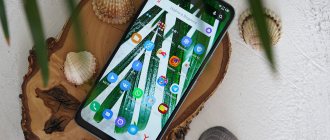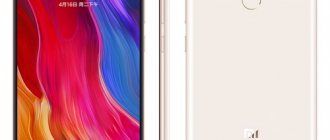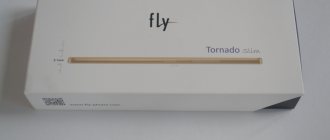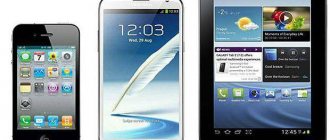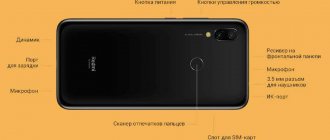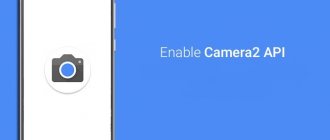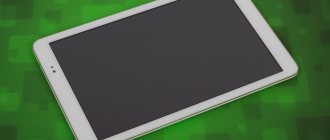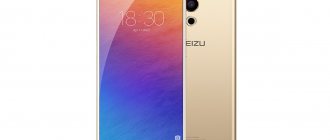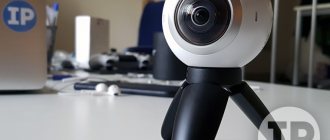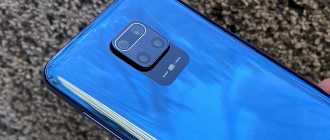Main Features of BQ BQS-5070 Magic
| Screen | S-IPS, 5″, 720×1280, multi-touch 5 touches |
| Iron | 1.25 GHz, Mediatek MT6737, 4 cores Cortex-A53, Mali-T720 |
| Memory | RAM 2 GB, ROM 16 GB, Micro-SD up to 128 GB |
| Mobile Internet | LTE cat.4 150/50 Mbit/s HSDPA, HSUPA EDGE |
| Mobile networks | LTE Bands 1,3,7,20,38 UMTS 900, 2100 GSM 850, 900, 1800, 1900 |
| Battery | Li-Ion, 2000 mAh |
| Dimensions | 143 x 71 x 7.9 mm |
| Weight | 136 g |
| Camera | 13 MP, flash, autofocus front: 5 MP |
| Navigation | GPS, A-GPS |
| OS | Android 6.0 Marshmallow |
| SIM | Micro-SIM + Nano-SIM |
| Price | 7490 rub. |
Russian BQ (not to be confused with Spanish BQ) began working on smartphones in 2014. They have released a lot of models over the past three years. From time to time there were funny ones among them. But everything is somehow very weak in its characteristics. But they are inexpensive.
Things got more interesting in 2020. In the summer, the super-thin BQ BQS-4800 Blade appeared, and in the fall, a couple of interesting 4G smartphones BQ BQS-5520 Mercury 5.5″ and BQ BQS-5070 Magic 5.0″ appeared. Yes, they are not top-level at all, but if you look at the characteristics, they are very competent devices that cost reasonable money. Two gigabytes of RAM, fresh processors, etc.
The first of this pair, BQ BQS-5520 Mercury, pleased me very much (see review) and deserved almost the maximum rating - 9/10.
With Magic everything turned out to be a little less fun - due to the weak battery. Otherwise, everything is not bad, plus the appearance is nice.
Now let's talk about everything in order.
Competitors
What are we looking for? Classic five-inch devices with 4G support, a normal screen and at least two gigs of RAM.
Apart from the “gray” Chinese, it turns out that BQ Magic is doing well with its price. Competitors are either more expensive or less interesting. And almost everyone has an older and slower MT6735 processor
| Chipset | Memory | Screen | Battery | Cameras | Price | |
| Ark Impulse P2 LTE | MTK6735 | 2+16+SD | 720×1280 | 2100 | 8+2 | 7-9 thousand |
| Micromax Q462 | MTK6735P | 2+16+SD | 720×1280 | 2000 | 8+5 | 7-9 thousand |
| DEXP Ixion MS350 Rock Plus | MTK6735P | 2+8+SD | 720×1280 | 3140 | 8+5 | 8 thousand |
| ZTE Blade A476 | MTK6735 | 2+8+SD | 720×1280 | 2200 | 8+5 | 8-9 thousand |
| Alcatel POP Up | Snap.610 | 2+16+SD | 720×1280 | 2000 | 13+5 | 8-9 thousand |
| ZTE Blade X7 | MTK6735 | 2+16+SD | 720×1280 | 2200 | 13+5 | 8-9 thousand |
| TP-Link Neffos C5 | MTK6735 | 2+16+SD | 720×1280 | 2200 | 8+5 | 9 thousand |
| Huawei Honor 5A | MTK6735P | 2+16+SD | 720×1280 | 2200 | 13+5 | 9 thousand |
| DEXP Ixion ML150 Ampere M | MTK6735 | 2+16+SD | 720×1280 | 5200 | 13+2 | 9 thousand |
| Wileyfox Spark+ | MTK6735A | 2+16+SD | 720×1280 | 2200 | 13+8 | 9 thousand |
| Wileyfox Swift | Snap.410 | 2+16+SD | 720×1280 | 2500 | 13+4.9 | 9 thousand |
| Highscreen Prime L | MTK6735 | 2+16+SD | 720×1280 | 2300 | 8+5 | 9 thousand |
| ASUS ZenFone Go (ZB500KL) | Snap.410 | 2+16+SD | 720×1280 | 2600 | 13+5 | 9-10 thousand |
| Huawei Y6 LTE | Snap.210 | 2+8+SD | 720×1280 | 2200 | 8+2 | 9-11 thousand |
| Meizu m2 mini | MTK6735 | 2+16+SD | 720×1280 | 2500 | 13+5 | 9-13 thousand |
| Acer Liquid Zest 4G Z528 | MTK6735 | 2+16+SD | 720×1280 | 2000 | 8+5 | 9-11 thousand |
| Ginzzu S5050 | MTK6735P | 2+16+SD | 720×1280 | 1900 | 13+5 | 9-10 thousand |
| Archos 50 Power | MTK6735P | 2+16+SD | 720×1280 | 4000 | 13+2 | 9-10 thousand |
| Micromax Q465 | SC9832 | 2+16+SD | 720×1280 | 3900 | 8+5 | 10 thousand |
If you are not afraid of the Chinese, you can look, for example, towards the Oukitel K7000 or Doogee X5 MAX Pro - both can be bought for six thousand with free shipping.
Hardware
It's time to pay attention to the “stuffing” of the BQ 5070 Magic. The characteristics of the gadget do not match those of a flagship, but the device copes well with its tasks. Its “heart” is the processor of the famous company MediaTek. The MT6737 model runs on four computing elements. Each of them is capable of delivering a maximum clock frequency of 1250 MHz. The well-known Mali-T720 MP2 video card was used as a graphics accelerator. This tandem is found on many inexpensive devices.
What pleasantly surprised buyers was the amount of RAM. In this model, the developers installed 2 GB. This is quite enough to ensure uninterrupted operation. All main processes function without freezes or failures. As for ROM, the device has only 16 GB. About four are already occupied by system files, so the user will only be able to work with 12 GB. If this storage is not enough for someone, you can install a 128 GB flash drive.
Appearance
| Weight | 136 g |
| Size | 143 x 71 x 7.9 mm |
| Protection | No |
The appearance is in perfect order.
Six colors, and very entertaining ones.
My copy is white with golden sides.
Plastic. The front is normal glossy. The back is matte, as if it was painted with white paint on a gray background. Pleasant to both the eye and the touch. The chamfers beveled at 45 degrees - oddly enough, are also surprisingly appropriate.
The camera is nicely designed. A golden puck with a noticeably protruding edge.
The assembly is good. The back cover is removable (albeit with some difficulty), and so is the battery. Under the cover there are two slots for SIM cards (Nano-SIM + Micro-SIM) and a separate slot for a memory card.
Some boring details
Above the screen are sensors, a front camera, and a speaker. Unfortunately, there is no LED. They saved money on it.
Under the screen there is emptiness, android buttons on the screen.
On the back there is a camera with flash.
At the bottom rear there is a speaker.
The top edge is a 3.5 mm audio output and Micro-USB (the noise-canceling microphone is not visible).
Bottom - microphone.
The volume rocker is on the left side.
The shutdown button is on the right.
BQ-6040L Magic: configuration and design
As usual, at a low price, we don’t expect rich equipment: in addition to the device itself, in the box you will only receive a power adapter and a USB-microUSB charging cable. The protective film is glued to the smartphone from the factory, but there is no cover included and, perhaps, this is a bit of a minus for this particular phone model. A little lower in the text we will return to this issue and tell you why we came to this conclusion.
You've probably already noticed that BQ likes to experiment with case colors. So the BQ-6040L Magic is offered not only in traditional black colors, but also in dark blue and cherry. It is more pragmatic to take a black smartphone - it uses a different type of plastic and the surface is matte rather than glossy. The fact is that the glossy back of the smartphone became covered with small scratches after a week of use and was slightly worn out. At the same time, the smartphone was in a soft case most of the time.
But we must pay tribute: thanks to the gradient tints, the body looks fashionable, beautiful and expensive. Purely visually, the smartphone does not look like a budget smartphone, but rather a middle-class one. It’s a pity that the glossy finish in general is easily soiled (this applies in principle to any smartphone). If you don’t paw it too much, holding the BQ-6040L Magic by the side edges made of matte plastic, then the aesthetic appearance will last longer, but it’s better to still buy a case or protective glass for the back side so as not to “overwrite” such beauty. After all, the “magic” of iridescent colors is one of the model’s calling cards.
Once again, we emphasize that the smartphone in black is made of matte plastic, so it is not in danger. Otherwise, the device feels solid and reliable, despite its light weight of 161 grams. Operating it with one hand is also convenient, although the diagonal is large - 6.09 inches with narrow frames (no more than 2 mm). The tray for installing SIM cards and microSD drives is not combined here, which is another unconditional plus.
Internals (iron)
| AnTuTu | 29299 (v6.2.6) |
| AnTuTu | 25620 (v5.7.1) |
| Chipset | Mediatek MT6737 |
| Cores | 4 x Cortex-A53 1.25 GHz |
| GPU | Mali-T720 |
| RAM (free) | 2 GB (1 GB) |
| ROM (free) | 16 GB (9 GB) |
| Micro-SD | Up to 128 GB |
The Mediatek MT6737 processor is already familiar to me. Exactly the same as in the BQ BQS-5520 Mercury. Only works in 64-bit mode. However, it is hardly possible to feel the difference in performance. The number of bits with two gigabytes of RAM makes no difference to you and me. Sort of.
Low-end processor. However, the performance is, in my opinion, quite satisfactory.
Special thanks for not being greedy with memory, especially RAM.
Sensors - to a minimum. Accelerometer, illumination, proximity. There is no compass, no gyroscope, no fingerprint sensor.
Some synthetic tests
⇡#Hardware and performance
BQ Magic has an unusual platform. We have long been accustomed to the dominance of Mediatek in budget models and Qualcomm in everything that is more expensive than 10-15 thousand rubles. With small inclusions of companies’ own developments (HiSilicon, Samsung, Apple). But the “magic” smartphone turned out to be equipped with a UNISOC chip – a company formerly known as Spreadtrum. In this case we are talking about the SC9863A system-on-chip.
It consists of four ARM Cortex-A55 cores with a clock frequency of 1.6 GHz and four of the same, but with a reduced frequency of 1.2 GHz. GPU – PowerVR IMG8322. The technological process used to produce the platform is 28 nm. The platform also includes an LTE modem and supports Full HD screens. All this does not look very modern, but in general the platform provides the smartphone with quite normal performance.
We did not have the opportunity to compare the BQ Magic in terms of performance with direct competitors equipped with Mediatek platforms, but even compared to more expensive smartphones it looks quite decent. There is no need to talk about any serious gaming abilities, but all basic applications open and work without failures. The system lacks overall smoothness; it slows down in various aspects, but it does not lead to critical problems.
The cooling system in BQ Magic copes with its tasks confidently. In the CPU Throttling Test benchmark, the average performance was 78 GIPS with the operating frequency dropping to 78% of the maximum. These are very good indicators, above average for budget smartphones.
I also tested BQ Magic in the Ludashi AI Mark benchmark, since it claims to work with neural network calculations. And the figure of 4440 points is a really good result. Moto g7, for example, has 4480 points, and Xiaomi Redmi Note 7 has 5558 points.
The BQ Magic has 3 GB of RAM - even if you install “full-size” Android 9 Pie, this is enough for a smartphone with an HD screen. The drive is 32 GB, which is also normal given the ability to expand the volume using a memory card. There is a separate slot for it; you don’t need to remove the second SIM card for it. MicroSD up to 128 GB is supported.
Screen
| Matrix | S-IPS |
| Diagonal | 5″ |
| Permission | 720×1280 |
| Multi-touch | 5 |
| Max white brightness | 246 cd/m2 |
| Min white brightness | 9.1 cd/m2 |
| Contrast | 700:1 |
| Color temp. | 10400K |
| Gloves | No |
The screen is quite black, i.e. The IPS matrix is not very, very cheap. However, there is nothing much to brag about. Low brightness, no oleophobic coating.
The default color temperature is high. However, it doesn’t matter, picky people can quietly adjust it in the depths of the screen settings.
There are no newfangled 2.5D fillets.
BQ Majdik – design, screen
The appearance of the smartphone is modern, but not original. Here is a typical representative of the market: an elongated screen with an aspect ratio of 19.5:9, a plastic body with a glossy finish, a dual main camera sensor, a fairly thin body and a round fingerprint scanner. The BQ-6040L Magic is available in three colors: blue, red and black. The system control buttons and connectors are in the usual places: the volume rocker and smartphone unlocking are on the right side, on the top there is a headphone jack, on the bottom there is a USB 2.0 connector and an external speaker. The dimensions of the BQ-6040L Magic are comfortable and do not go beyond what is permitted: dimensions – 73.3x156x8.7, weight – 161 grams. The phone is comfortable to use with one hand - there are minimal questions about ergonomics. There are problems with fingerprints on the smartphone body, but the case solves all problems.
The display of the BQ-6040L Magic is of impressive size and mediocre characteristics: 6.09'', resolution 720x1560, 282 ppi, IPS matrix, 80% of the usable area of the front panel, 2.5D glass. Advertising articles report that the display occupies 90%, but in reality the numbers are different. There is a drop-shaped cutout for the front camera. This looks less hackneyed than, for example, a “unibrow”, and also saves more space directly for the display. The screen is covered with a special protective glass Panda Glass, which already has an oleophobic coating applied, which increases the comfort of interaction. The display handles five simultaneous touches. As for color rendition, it is at a good level - suitable for daily use. If you switch to the BQ-6040L Magic from a smartphone with FullHD resolution, then you will, of course, see the difference in detail, but you will quickly get used to it and it will not put any pressure on you. From design and screen let's move on to .
Battery
Battery capacity is a modest 2000 mAh. The battery test results are sad, only 71% of the standard. Naturally, I assumed that it wouldn’t be chocolate. But for it to be so bad is even strange.
| Full discharge time | Discharge in an hour | |
| Video | 5:20 | 18.8% |
| Video HD | 4:30 | 22.5% |
| Easy game | 3:40 | 27.3% |
| Hard game | 2:50 | 35.1% |
| Telephone | 7:40 | 13.0% |
| Music | 25:40 | 3.9% |
| GPS on 3G window | 2:50 | 35.3% |
| GPS on Wi-Fi window | 2:50 | 34.7% |
| White screen | 7:40 | 13.0% |
| White screen 100% | 5:10 | 19.1% |
| White screen 0% | 16:50 | 6.0% |
| Internet 3G | 3:20 | 29.3% |
| Internet Wi-Fi | 5:10 | 19.4% |
| Slow 3G torrent | 7:00 | 14.3% |
| Slow torrent Wi-Fi | 28:00 | 3.6% |
BQ-6040L Magic: Autonomous operation
The battery capacity here is 4000 mAh, which is not bad at all for a smartphone costing 7,999 rubles. To fully charge the battery it will take about 3 hours from a standard 5V/1.5A charger (included). Unfortunately, there is no support for Quick Charge technology. According to the manufacturer, the battery capacity is enough for 13 hours of video playback, but in fact it is only enough for 8 hours of watching 720p HD video at maximum screen brightness. However, this is a very good result compared to competitors.
In mixed mode of use (navigator, photographs, communication in instant messengers), the smartphone lasts for one and a half to two days. With constant activity, the battery drains within a day. For example, using the phone as a navigator and camera for a week, the battery ran out within 10 hours with the screen always on and brightness at 80%. Thumbs up. And if you also correctly configure the energy saving mode, autonomy will increase.
BQ BQS-5070 Magic as a photo and video camera
| Rear: | 13 MP, AF |
| Front: | 5 MP, FF |
For its money, the camera shoots quite confidently. Those. There is no such thing that you need to duplicate any picture three times, because every second frame will be a complete wash. But don't expect miracles, of course. The camera is not for highly artistic memory photography.
More photos
More photos
The front camera is of quite reasonable quality. My favorite selfie with chewing background.
BQ Magic – camera, photo
There are no decent camera phones in the price category of the participant in our review. There are smartphones that take decent photos, but don't expect anything special from the BQ-6040L Magic. The main camera of the smartphone consists of two sensors working in pairs: the main one is 13 MP, the secondary one is 2 MP. The latter helps analyze depth of field and take portrait shots with background blur. The quality of the images is saved a little by the artificial intelligence algorithm, but not much. Front camera – 5MP. Takes decent self-portraits and is suitable for video calls and face unlocking.
BQ BQS-5070 Magic as a toy
The games are fine.
| A game | Problems? |
| Pitfall! | Everything is fine |
| Shoot The Zombirds | Everything is fine |
| Asphalt 8: Take Off | There are no problems with racing, but for some reason the interface is very slow. |
| Real Racing 3 | Everything is fine |
| NOVA 3 | Everything is fine |
| Need for Speed Most Wanted | 30 seconds of game time = 33 seconds of real time. |
| Grand Theft Auto: San Andreas | Everything is fine |
| Dead Trigger 2 | Maximum graphics |
| Riptide GP2 | Everything is fine |
| FIFA 15 | Everything is fine |
BQ-6040L Magic: characteristics and competitors
| Smartphone model | BQ-6040L Magic | Huawei Y6 | Honor 8A |
| Screen | 6.09″, IPS, HD+ (1560×720 pixels) | 6.09″, IPS, HD+ (1560×720 pixels) | 6.09″, IPS, HD+ (1560×720 pixels) |
| CPU | 8 cores Qualcomm Unisoc SC9863A | 4 cores, MediaTek MT6761 | 8 cores, MediaTek MT6765 |
| operating system | Android 9.0 | Android 9.0 | Android 9.0 |
| RAM/ROM | 2 GB / 32 GB | 2 GB / 32 GB | 2 GB / 32 GB |
| Cameras (main/front) | 13+2 Mpix / 5 Mpix | 13 Mpix / 8 Mpix | 13 Mpix / 8 Mpix |
| Battery | 4000 mAh | 3020 mAh | 3020 mAh |
| NFC | Eat | No | Eat |
| Price | 7990 rub. | 9490 rub. | 9990 rub. |
| Advantages | The BQ-6040L Magic has a more powerful processor, a dual camera, a higher battery capacity and NFC on board. The price is also better. | The BQ-6040L Magic has a dual camera module, a more capacious battery and a lower cost of 2,000 rubles. |
Did you like the article? Share with your friends!
Screen and image
The screen is based on an IPS matrix with a diagonal of 6.35 inches, a resolution of 1560 x 720 and an aspect ratio of 19:9. The pixel density is 271 ppi, which ensures image transmission without noticeable grain and pixelation.
You quickly get used to the location of the cutout for the selfie camera, and it does not distract when watching videos on YouTube. You can turn on adaptive screen brightness - it works stably until you take the smartphone horizontally, blocking the light sensor on the top end with your hand.
Color reproduction is accurate, shifting only at acute viewing angles. There is a reserve of brightness for working in the sun. The touch layer works accurately. There are no comments on the screen; the IPS matrix in the phone is excellent.
Detailed technical specifications
Make and model
Make and model of the device, and alternative names (if any).
| Brand Device manufacturer company. | BQ Mobile |
| Model Device name. | BQ-5731L Magic S |
| Alternative names Other model names, if available. Sometimes the model is called differently, depending on the country or because of popular nicknames. | 5731L |
Design
Appearance of the device including dimensions, weight, volume, colors and materials.
| Width The horizontal side of the device when used in standard orientation. | 71.9 mm (millimeters) |
| Height The vertical side of the device when used in standard orientation. | 148.8 mm (millimeters) |
| Thickness The cross-sectional size of the device. | 9.2 mm (millimeters) |
| Weight How much does the device weigh excluding the case, SIM and memory cards and other additional elements. | 155 g (grams) |
| Volume Approximate value calculated using the formula: length times width times height. | 98.43 cm³ (cubic centimeters) |
| Colors What colors is the device available in? | Dark Blue Wine Red Purple |
| Housing materials What materials is the body made of? | Plastic |
System on a Chip (SoC)
A system on a chip, a single-chip system (System on a Chip, SoC) is when several systems performing different device functions are connected on one chip.
| System on a Chip (SoC) A single-chip system that contains components such as a processor, graphics accelerator, memory units, communication interfaces, etc., as well as software for the operation of the system. | Unisoc SC9863A |
Central processing unit (CPU)
| Central processing unit (CPU) The main component of the device is responsible for calculations and data processing. | 4x 1.6 GHz ARM Cortex-A55, 4x 1.2 GHz ARM Cortex-A55 |
| Technical process What technological process is used to make the chip? The smaller the process technology, the better - the chips consume less power and generate less heat. | 28 nm (nanometers) |
| Processor size Processor capacity is a parameter that indicates how many bits of data a processor register processes in 1 clock cycle. This is usually 32 or 64 bits. | 64 bit |
| Instruction Set Architecture Instruction set architecture (ISA) is a programmable part of the microprocessor core used by software to control the operation of the processor. | ARMv8-A |
| Number of processor cores The processor can be either single-core or multi-core. The performance of the processor depends on the number of cores (threads). The more cores working simultaneously, the higher the power consumption, so in mobile devices all cores are used only under high load. | 8 |
| CPU clock speed Clock speed is the number of operations per second that a processor or its core can achieve. The higher the frequency, the higher the overall performance of the device, but performance also depends on the processor architecture and the number of cores. | 1600 MHz (megahertz) |
Graphics Processing Unit (GPU)
| Graphics Processing Unit (GPU) The graphics processing unit (GPU) is used to process and display graphics - 3D effects, games, interfaces and other visual elements. Due to the pipeline architecture, the GPU is many times more efficient in graphics processing than the processor. | PowerVR GE8322 |
Random access memory (RAM)
| Amount of random access memory (RAM) RAM (Random Access Memory, RAM, RAM) is temporary memory (works only while the device is running), which stores data and code for the operational operation of programs and applications. The more RAM, the more programs you can run simultaneously without loss of performance (there will be fewer “brakes”). | 3 GB (gigabytes) |
Built-in memory
Most mobile devices have built-in Flash memory, which is used as a storage for system data, the operating system, as well as user data - photos, videos, recordings and much more.
| Built-in memory capacity The higher the amount of built-in memory, the more games, programs, music, videos and your other files will fit in the device, especially the amount of memory is important when the device does not support memory cards. | 32 GB (gigabytes) |
Operating system
A mobile operating system (OS) is pre-installed software with a well-thought-out interface for user control of device functions.
| Operating system (OS) The operating system installed by default by the device manufacturer, as well as its version. | Android 9.0 Pie |
Battery
To operate autonomously, a mobile device requires a battery that powers all its components.
| Battery capacity The main characteristic of a battery is its maximum capacity, that is, the charge it can store. Capacity is measured in mAh (mAh, milliamp-hour). The higher the capacity, the longer the mobile device can work. | 3650 mAh (milliamp-hours) |
| Battery type Many types of batteries have been used in portable devices, but NiCd (nickel-cadmium), NiMH (nickel-metal hydride), and even more so SLA (lead-acid) batteries are already considered obsolete. Instead, modern mobile devices use Li-Ion (lithium-ion) and Li-Pol, Li-Poly (lithium-polymer) batteries. | Li-polymer |
| Power adapter Characteristics of the charger (adapter, power supply) included in the standard package of the mobile device. More precisely, the output voltage in volts (V) and the output current in amperes (A). | 5 V (volts) / 1.55 A (amps) |
Screen
The screen (display) is the main element for displaying graphic information.
| Technology The technology used to make the screen. There are many types of display manufacturing with their pros and cons. | IPS |
| Diagonal The screen diagonal of a device is measured in inches (inch, in or simply ″), and 1″ is equal to 2.54 cm. | 5.84 in (inches) 148.34 mm (millimeters) 14.83 cm (centimeters) |
| Width Approximate screen width | 63.5 mm (millimeters) 6.35 cm (centimeters) |
| Height Approximate screen height | 134.06 mm (millimeters) 13.41 cm (centimeters) |
| Aspect Ratio Aspect ratio is the ratio of the shorter side of the screen, which is considered to be 1, to the longer side, which is denoted by a decimal fraction indicating the ratio to the short side. | 2.111:1 |
| Screen resolution Screen resolution is the number of horizontal pixels (dots) multiplied by the number of vertical pixels. The higher the resolution, the more detailed the image will be. | 1080 x 2280 pixels |
| Pixel Density The number of pixels per inch or PPI (pixels per inch) indicates the density of pixels per 1 inch (2.54 cm) of the screen. The higher the PPI, the sharper the image, and the less visible or even invisible “squares and dots” (pixels). | 432 ppi (pixels per inch) 169 ppcm (pixels per centimeter) |
| Color depth Color depth means how many bits are used in 1 pixel to display color (bits per pixel). | 24 bit 16777216 colors |
| Screen area Approximate usable area occupied by the screen on the front of the device. The higher the percentage, the narrower the frames around the display or the smaller the “chin with bangs.” | 79.82% (percent) |
| Touch screen A touch screen is a device that usually covers the display and is a touch input tool. In fact, in mobile devices, the touchscreen is a replacement for the keyboard and mouse. | Yes |
| Touch screen type There are many types of touch screens, with their pros and cons. Mobile devices often use capacitive touchscreens, but technology does not stand still and new types of sensors are appearing. | Capacitive |
| Multi-touch Touch screen support for two or more touches. For example, zooming photos with two fingers. | Yes |
| 2.5D screen 2.5D is a display with rounded edges. Device manufacturers use a 2.5D screen as a design element, for a pleasant tactile sensation, or to add durability, dust and moisture protection. | Yes |
Main camera
The main camera, usually built into the rear of the device, is designed for creating photo and video content.
| Maximum image resolution This is the maximum number of pixels (dots) horizontally and vertically. The higher the resolution, the more detailed the image will be. Resolution can also be indicated in megapixels - this is the total number of pixels that can be in the image, calculated by the formula: vertical pixels multiplied by the number of horizontal pixels and divide the resulting amount by 1 million. | 16 MP (megapixels) |
| Flash type Most mobile devices are equipped with light-emitting diode (LED) flashes, but there are also xenon flashes. As a flash, xenon is better - it is more powerful, but LED is more versatile (can work as a flashlight) and consumes less electricity. | LED |
| Maximum video resolution This is the maximum number of pixels (dots) horizontally and vertically. The higher the resolution, the more detailed the image will be. | 1920 x 1080 pixels 2.07 MP (megapixels) |
| FPS video recording at maximum resolution FPS (Frames per Second, frame rate) is the number of frames that changes in 1 second. The higher the number of frames per second, the smoother the image will be. In this case, we mean the number of frames that the camera can achieve at its maximum resolution; the lower the resolution, the higher the FPS can be. | 30 fps (frames per second) |
| Presence of flash Incorporating a flash into a mobile device allows you to take pictures in low light conditions. Creates the necessary lighting and compensates for the lack of natural light. | Yes |
| Digital zoom With digital zoom (zoom, enlargement), the subject is brought closer due to software image algorithms. The higher the magnification with digital zoom, the worse the image quality (noise, blur) will be compared to a non-zoomed one. | Yes |
| Focus on face Function of auto-detection of living objects and autofocus on their face or head. | Yes |
| Panoramic shooting mode Panoramic photography is a series of frames where each subsequent frame is a continuation of the previous one; at the end of the shooting, all frames are stitched together at the software level to create a panoramic photograph. Frames can be shot both vertically and horizontally, and their width can be up to 360 degrees. This type of shooting is used when the camera's viewing angle is not enough to capture the entire scene. | Yes |
| HDR shooting mode HDR photography takes a quick series of shots with highlights, midtones, and shadows, then combines them into a single frame with high dynamic range. | Yes |
| White balance White balance is a setting that helps ensure the correct color reproduction in an image by determining the color temperature of the light source in the frame. The balance can be set either automatically or manually. | Yes |
| ISO Setting ISO is the level of light sensitivity. The lower the ISO, the less sensitive the camera's light sensor and the smoother the image with less noise. The higher the ISO, the higher the light sensitivity, but more noise, graininess, or decreased sharpness. | Yes |
| Additional Information Additional information about the functions and characteristics of cameras. | Autofocus Continuous shooting Geo-tagging Touch focus Exposure compensation Self-timer Scene selection mode Phase detection autofocus (PDAF) |
Additional cameras
Secondary cameras allow you to expand the capabilities of the main camera, such as adding a wide shooting angle, sharpness, optical zoom and other functions depending on the type of secondary camera.
| Second additional camera | 0.3 MP (megapixels) |
Front-camera
The front camera of a mobile device (selfie camera, rear camera) is a camera on the front part, which is usually used for video communication, recognition of gestures or faces, and selfie photographs.
| Photo resolution The maximum image resolution that the camera can produce. As resolution increases, image detail increases. Resolution can also be indicated in megapixels (the total number of pixels that an image can consist of) - these are vertical pixels multiplied by horizontal pixels and divided by 1 million. | 16 MP (megapixels) |
| Video resolution This is the maximum resolution the camera can record video at. The higher the resolution, the better. | 1920 x 1080 pixels 2.07 MP (megapixels) |
| Frame rate (FPS) of video shooting This is talking about FPS at maximum video resolution; at lower resolutions, the frame rate per second can be higher. FPS determines the smoothness of the video, as well as the ability to speed up or slow down it. | 30 fps (frames per second) |
Memory card
A memory card (flash card) is an external data storage device that is used in many devices to increase memory capacity.
| Memory card type and formats Mobile devices usually use 3 types of memory cards - SD, miniSD and the most common microSD. Each type has its own formats that the device supports. | microSD microSDHC microSDXC |
SIM card
Subscriber Identification Module (SIM) used in mobile devices to identify subscribers in cellular networks.
| Type, size of SIM card A regular (mini SIM) card has dimensions of 25x15 mm. Micro SIM - 15x12 mm. Nano SIM - 12.3x8.8 mm. The sizes of SIM cards are different and not interchangeable. There is also an eSIM (virtual, electronic SIM card), it is built into the device and does not take up space. | Nano-SIM (4FF - fourth form factor, since 2012, 12.30 x 8.80 x 0.67 mm) |
| Number of SIM cards How many SIM cards does the device support? | 2 |
| Additionally Additional information about the operation of SIM cards in the device. | Dual SIM stand-by (Both cards are active. When one is busy talking, the other is deactivated.) |
Mobile networks
This is a system in which communication and data transfer is carried out between subscribers, the location of one or more of which changes. This section lists the supported mobile communication standards and frequencies.
| GSM GSM (Global System for Mobile Communications) is a standard for digital mobile cellular communications of the second generation 2G with time and frequency division of channels. GSM came to replace analog cellular communications 1G (first generation). | GSM 850 MHz (B5) GSM 900 MHz (B8) GSM 1800 MHz (B3) GSM 1900 MHz (B2) |
| LTE LTE (Long-Term Evolution, often referred to as 4G LTE) is a standard for wireless high-speed data transmission, which, although it belongs to fourth generation networks (4G), is essentially a transitional stage from 3G to 4G, greatly accelerating data transfer speeds. The standard has an improved version, LTE Advanced (LTE-A), which can already be considered a full-fledged 4th generation network. | LTE-FDD 800 MHz (B20) LTE-FDD 1800 MHz (B3) LTE-FDD 2100 MHz (B1) LTE-FDD 2600 MHz (B7) |
| WCDMA WCDMA (W-CDMA, Wideband Code Division Multiple Access) is a third generation mobile communication standard (3G), which is an add-on to GSM and provides high-speed Internet access. | W-CDMA 900 MHz (B8) W-CDMA 2100 MHz (B1) |
Mobile network data standards
What data transfer standards in cellular networks are supported by the device, as well as their speed.
| Data transmission technologies Technologies for receiving and transmitting data, as well as their maximum speed. | UMTS (384 kbit/s) EDGE GPRS HSPA+ LTE Cat 6 (51.0 Mbit/s, 301.5 Mbit/s) |
WiFi
Wi-Fi (Wireless Fidelity) is a technology for wireless data transmission over a local network among devices based on IEEE 802.11 standards.
| Wi-Fi Direct support The Wi-Fi Direct protocol allows multiple devices to connect directly, bypassing the use of routers or access points. | Yes |
| Wi-Fi Hot-Spot A hotspot is a Wi-Fi access point. In a mobile device, Hot-Spot turns the smartphone into a Wi-Fi access point, essentially turning it into a router capable of distributing the Internet. | Yes |
| WiFi Supported WIFI wireless network standards. | 802.11b (IEEE 802.11b-1999) 802.11g (IEEE 802.11g-2003) 802.11n (IEEE 802.11n-2009) |
Bluetooth
Bluetooth (BT, bluetooth (z), “blue tooth”) is a short-range wireless network (up to 10, sometimes 100 meters) operating on radio waves to transmit voice and data between devices.
| Bluetooth version Bluetooth technology is actively developing and, since 1998, has been constantly updating versions of the standard. Each subsequent version introduces one or several improvements in data exchange speed, range, facilitates pairing, reduces power consumption, or introduces some new protocols and operating profiles. The higher the Bluetooth version, the better. The technology is also backward compatible, for example, if your mobile device has version 5.0, then it will work with accessories version 4.2 and lower, but the improvements introduced in version 5.0 will not work; they will work only if both the device and accessories are version 5. | 4.2 |
| Bluetooth Low Energy (BLE) Bluetooth LE is a low energy BT protocol specification. | Yes |
| A2DP profile The A2DP Bluetooth profile is designed to transmit a high-quality two-channel stereo signal via Bluetooth to wireless headphones, speakers and other acoustics. | Yes |
Sensors
Modern devices have many sensors that help in measurements, trigger functions, and make using the device more pleasant.
| Light sensor The light sensor reacts to the light level and is able to adjust the screen brightness automatically based on this. This is necessary to reduce power consumption and ease of use of the device. | Yes |
| Proximity sensor The proximity sensor reacts to the proximity of the mobile device to some object. For example, the sensor is used when talking on the phone to turn off the screen, which saves energy and prevents you from pressing buttons with your ear or cheek. | Yes |
| Accelerometer An accelerometer is a sensor that measures apparent acceleration, that is, it determines the position and distance at which a mobile device moves in space. Based on the data from this sensor, the screen orientation change, pedometer, control using tilts and gestures in games and applications, etc. work. | Yes |
| Fingerprint's scanner The scanner is responsible for authorization using a previously saved fingerprint, as a result of which the device is unlocked, payment is made, some action is confirmed - just put your finger on the scanner. Scanners can be either built into the body or built into a button or screen. | Yes |
| Additional sensors |
Audio
Audio - characteristics and capabilities of a mobile device in terms of sound.
| Music speaker There are two types of speakers in mobile devices - auditory and musical. The auditory speaker (speaker) is used for conversation, the music speaker (buzzer) is used to play music and sounds. | Loudspeaker Earphone |
Radio
The radio in a mobile device can be built-in by the manufacturer (catch local radio channels, no internet required, often works only with headphones (as an antenna), but not always) or installed as an online application (requires internet, but more channels and often better quality) .
| Built-in radio Is a radio tuner integrated into the mobile device? | Yes |
Navigation and location
The location is determined by satellite navigation systems that track the device's autonomous geospatial location at multiple points. The most common satellite navigation systems are GPS, GLONASS, and the Chinese BeiDou.
| GPS GPS (Global Positioning System) is a global satellite navigation system that can determine the position of a mobile device, build routes and find the desired object on the map with an accuracy of several meters. | Yes |
| A-GPS A-GPS (Assisted GPS) is an assistive technology that will help you quickly find the location of your cellular device without waiting for satellite data, which is especially important in indoors and cities. Location is determined in various ways, for example, Wi-Fi access points, mobile towers, bluetooth and others. | Yes |
| GLONASS GLONASS is a Russian Global Navigation Satellite System, which is similar to GPS and works in tandem with it, increasing the accuracy and speed of navigation. | Yes |
| Additional navigation systems |
USB connector
USB (Universal Serial Bus) is a serial interface for connecting peripherals to computers, smartphones, laptops and much more. The interface allows you to exchange data and power a peripheral device with energy, as well as connect several peripheral devices to one USB connector at once.
| Connector type What type of USB connector is used in the device. | Micro USB |
| USB standard The higher the standard, the faster the throughput, or more precisely the data exchange rate. With version 3.0 of the standard, the current was increased to 0.9A, eliminating the need for additional power for some devices. | 2.0 |
| USB Mass Storage Connecting a mobile device via USB as a data storage device. That is, when you enable this mode, your device can be used as a flash drive. | Yes |
| Additional characteristics Additional features of the USB connector, for example, OTG, whether the connection is supported, peripheral devices and additional memory. | Charging via USB |
Headphone jack
A TRS headphone jack (or jack) is a common standard of connectors used for transmitting audio signals. By diameter there are jack (6.5 mm), mini-jack (3.5 mm) and micro-jack (2.5 mm). In mobile devices, the 3.5mm jack was considered the most popular and widespread, but recently they began to be removed, leaving only USB connectors, through which headphones are connected with a corresponding plug or using adapters.
| 3.5mm headphone jack Does the device have a 3.5 mm audio jack? | Yes |
Connection and synchronization
Options for synchronizing your mobile device and connecting it to other devices.
| NFC NFC (Near field communication, near contactless communication) is a technology for contactless communication between devices over a short distance. Widely used for contactless payment, in the form of a travel card or pass, and is also used for reading and interacting with NFC tags and for exchanging data between devices. | Yes |
| Connection, synchronization Types of synchronization and connection technologies supported by the device. | Computer sync OTA sync Tethering |
Browser
A browser is a browser program for viewing sites and their content on the Internet. Through the browser, you can open websites, search for information, download necessary files, watch streaming videos, play browser games, etc.
| Technologies Markup and programming languages supported by the built-in (standard) browser. For mobile devices, you can install additional browser applications if the standard one does not suit you. | HTML HTML5 CSS 3 |
Audio file formats/codecs
Mobile devices support many audio file formats, as well as codecs for playing them.
| Default formats The formats that the mobile device supports out of the box are indicated. But if the device does not support the format you need, then you can try adding support for it. Sometimes support depends on the technical characteristics of the device (“hardware”) and nothing can be added here, but often the ability to process a particular audio format depends on the software part. You can install another audio player or codec set separately. | AAC (Advanced Audio Coding) AMR / AMR-NB / GSM-AMR (Adaptive Multi-Rate, .amr, .3ga) eAAC+ / aacPlus v2 / HE-AAC v2 FLAC (Free Lossless Audio Codec, .flac) MIDI MP3 (MPEG) -2 Audio Layer II, .mp3) OGG (.ogg, .ogv, .oga, .ogx, .spx, .opus) WMA (Windows Media Audio, .wma) WAV (Waveform Audio File Format, .wav, .wave ) |
Description of the advantages and disadvantages of the BQ-5731L Magic S phone
The dimensions of the BQ Mobile BQ-5731L Magic S are 71.9 mm wide, 148.8 mm long and 9.2 mm thick. With such dimensions it is convenient to operate the device with one hand. In addition, the weight of the device is about 155 g. Even if you operate the device with one hand, its weight is almost not felt.
If we evaluate the overall ease of use of the phone taking into account the size and weight, then there will be no problems with everyday use.
The smartphone is equipped with an 8-core Unisoc SC9863A processor, which is manufactured at 28 nm. technical process.
The smartphone has 3 GB. RAM, which is quite enough. In very rare cases it will not be enough, but with this amount of RAM, you will rarely have problems.
The device's data storage capacity is 32 GB, and while this is enough for photos, it may not be enough for video shooting and a large number of games.
The phone is compatible with SD cards, so you can easily expand its memory. So you probably don't need to worry about storage capacity.
The BQ-5731L Magic S has a display diagonal of 5.84 inches. It's quite big. Photos, videos and games will look great on this screen. It is also suitable for productive use, such as creating a business document.
The smartphone has a high-end display and any graphic content you display on it, including videos and games, will be displayed clearly.
The main camera of the phone has 16 megapixels and can take high-resolution photos and videos. While you're shooting landscapes or printing high-definition photos, you may want a higher-resolution camera, but most of the time you'll be happy with the camera.
The smartphone has a 16 megapixel front camera, which is quite high. Photos taken with this camera will look sharp even if you print them, so you will be quite satisfied with the quality of the camera.
The battery capacity of the BQ Mobile BQ-5731L Magic S is 3650 mAh, which is a relatively large figure. Compared to other smartphones, the battery life of the BQ Mobile BQ-5731L Magic S is good. With this capacity, you won't experience any problems even if you spend time on the Internet or Twitter for a long period of time. Even while playing games or watching videos, you can do so comfortably without worrying about battery life. However, some caution should be exercised when watching movies or playing games for too long.
⇡#Cameras
The set of cameras in the device is standard. The front camera here is five megapixel, without autofocus and its own flash. It can only be used if there is a light source, otherwise the picture will be too noisy.
BQ BQS-5070 Magic – main camera
The rear camera is more serious - it has a 13 megapixel sensor, complemented by an automatic focusing system and a single LED flash. You can see examples of photos taken with the main BQ Magic camera below.
BQ BQS-5070 Magic – examples of photos taken with the rear camera
View all images (5)
BQ Magic shoots quite standard. With sufficient lighting, photos come out well detailed, with natural colors and decent contrast. In rooms with artificial light, the picture becomes covered in noise and saturation is lost. It is possible to record video in Full HD format. A minute of recorded video takes up approximately 130 MB of disk space.
⇡#Display
As we said earlier, the smartphone has a five-inch display with HD resolution. The pixel density is moderate at 293.7 ppi. Of course, an eye spoiled by 400+ ppi will notice fine grain and slight roughness of the text - especially on icon captions. Nevertheless, HD is quite enough for movies and photographs, and even when reading electronic text, the eyes do not strain.
The screen is made using IPS technology. When you look away from the perpendicular, the contrast of the display noticeably drops. However, for inexpensive screens made using this technology, this is quite a typical phenomenon. The touch layer is quite responsive; it responds to touch quickly and accurately. The device easily recognizes gestures and understands up to five simultaneous touches. You can work with the gadget wearing loose gloves. The shell has built-in support for “smart gestures” on the locked screen - with their help you can quickly open the desired application, bypassing the lock screen.
| BQ BQS-5070 Magic – “smart slide” | ||
We are forced to once again emphasize that BQ Magic is a budget smartphone. And in this context, it is especially pleasing that its screen is made according to all modern canons: there is no air gap between the matrix and the protective glass of the front panel, and the glass is equipped with an oleophobic coating and a polarizing filter.
The display's brightness reserve is average. The maximum luminosity of the white field on the BQ Magic screen is 387 cd/m2, the minimum is 16 cd/m2. Such backlight boundaries make it relatively comfortable to work with the device under any conditions - both in complete darkness and in bright external lighting. It is noteworthy that the gadget can independently control the backlight level - the device has a light sensor. Brightness is adjusted smoothly to suit your surroundings.
The luminosity of the black field at maximum brightness is 0.37 cd/m2. For a mobile IPS matrix, this is a completely acceptable indicator – the black color looks rich. Static contrast ratio is normal: 1046:1.
BQ BQS-5070 Magic – grayscale color temperature
White balance is traditionally somewhat overwhelmed for a smartphone in this price segment. It is higher than the reference value of 6500 K - the average color temperature of shades of gray is 8250 K. The deviation is significant, because of it the picture on the BQ Magic screen looks colder than it should, this is especially noticeable on white. But the smartphone’s firmware contains MiraVision filters, which allow the user to adjust the color rendering of the screen to suit their tastes.
| BQ BQS-5070 Magic – preinstalled filters for MiraVision display | ||||
With gamma curves everything is more or less decent - they are all close to the standard. Of course, minus the blue curve - it is noticeably raised, which is not surprising at such a high color temperature.
| BQ BQS-5070 Magic – gamma curve of gray color (left) and color components (right) in comparison with the reference curve (indicated by a dotted line in the graphs) | ||
The color gamut of a smartphone screen is slightly different from the reference sRGB color space, to which most existing images are adapted. The deviations are by no means critical, and you can close your eyes to them.
BQ BQS-5070 Magic – smartphone screen color gamut (white triangle) compared to sRGB color space (black triangle)
